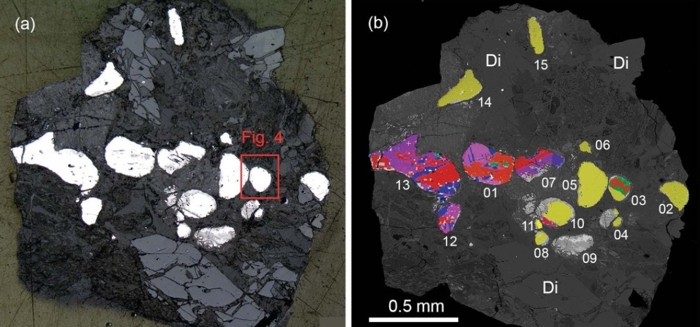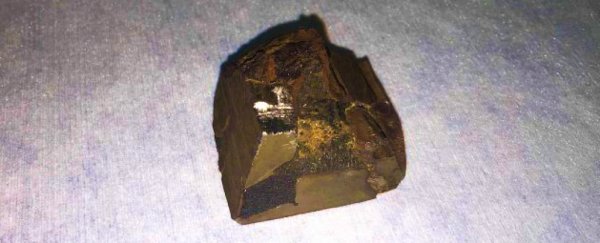A very rare mineral that's previously been found only in extraterrestrial meteorites has been discovered in Earth's own rocks for the first time, lying in a sedimentary formation not far from the shores of the Dead Sea.
Allabogdanite, a phosphide mineral, was unknown to science until just a couple of decades ago, after fragments of a small iron meteorite were recovered from the Bolshoi Dolguchan River in Eastern Yakutia, Russia.
A sample of the fragments later revealed the presence of a new mineral structure occurring as thin layers of crystals spread throughout the meteorite's plessite mixture. The discoverers named it after Russian geologist Alla Bogdanova.
Subsequently, allabogdanite has been found in other meteorites too, suggesting that the rare mineral might not be quite as exclusive as had been believed.
Even so, only being found in rocks falling out of the sky is still a pretty special status all told – and yet now it seems allabogdanite also has Earthly origins we never knew about.
 (Mineralogical Society of America)
(Mineralogical Society of America)
Above: General view of a sample from the Hatrurim basin. Left: Polished cross-section showing allabogdanite and barringerite grains (white pebbles). Right: The same fragment showing grains of allabogdanite (mixed colors) and barringerite (yellow).
In a new study, scientists report the discovery of allabogdanite in the Negev Desert of Israel, located to the southwest of the Dead Sea.
"The discovery of the high-pressure polymorph of (Fe,Ni)2P, allabogdanite in the surficial pyrometamorphic rocks of the Hatrurim Formation (the Mottled Zone) surrounding the Dead Sea basin in Israel is the first terrestrial occurrence of a mineral previously only found in iron meteorites," a team of researchers, led by crystallographer Sergey Britvin from St Petersburg University in Russia, explains in the new paper.
While the Dead Sea's allabogdanite might not come from outer space, it still remains possible – perhaps – that it was born out of some kind of extraterrestrial event, the researchers say.
Analysis of the Hatrurim sample – and experiments exploring how it transitions from its low-pressure polymorph state, the mineral barringerite – suggest this terrestrial allabogdanite only forms under extremely high pressure: over 25 gigapascals.
"Such high pressures on Earth can be attained during catastrophic collisions with large meteorite impactors, or at the Earth's mantle conditions, at a depth of more than 500 kilometers," Britvin says.
However, as there's no evidence of large meteorite collisions in the region – nor any signs that the rocks in the Mottled Zone have deep ties to Earth's mantle – it's not exactly clear how this terrestrial allabogdanite came to be.
If we can locate other instances of terrestrial allabogdanite, it might give us more to go on. But until we can find another source of this unusual mineral on Earth, it's hard to say more, the team concludes.
"Therefore, the origin of terrestrial allabogdanite in the rocks of the Mottled Zone remains unresolved and adds to the number of mineralogical enigmas of this unusual metamorphic complex," the researchers explain.
The findings are reported in American Mineralogist.
